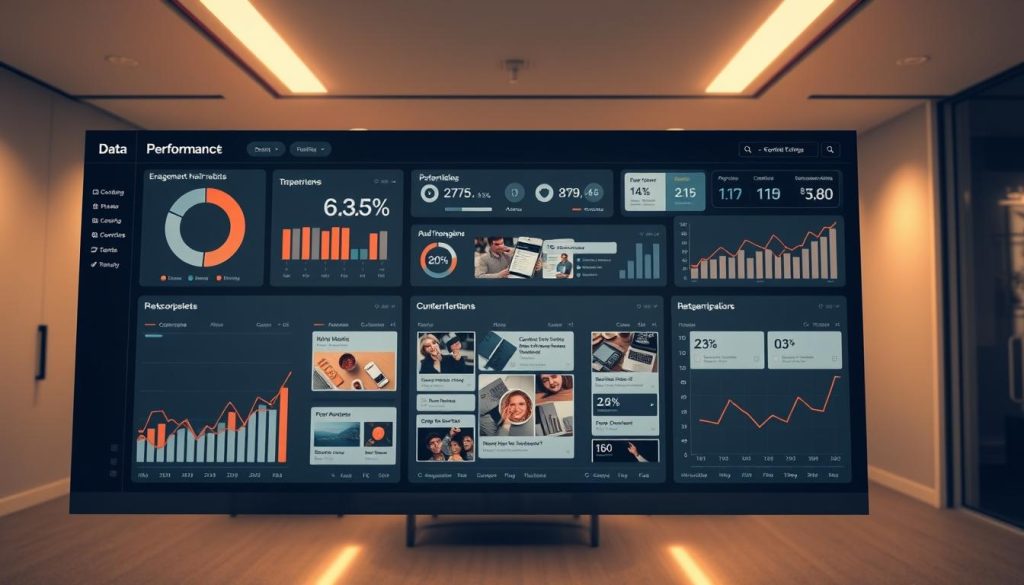Are you struggling to make your online presence felt? In today’s digital landscape, a well-crafted content marketing strategy is crucial for businesses and individuals alike.
Creating engaging digital content that resonates with your audience can be a game-changer. It’s not just about posting content; it’s about understanding your audience and using the right platforms to reach them effectively.
By mastering social media content creation, you can drive real results and boost your online presence. This involves more than just posting; it’s about creating a strategy that works for you.
Key Takeaways
Table of Contents
- Crafting a well-thought-out content marketing strategy is essential.
- Understanding your audience is key to creating engaging content.
- Using the right platforms is crucial for reaching your target audience.
- A strong online presence requires consistent and effective content creation.
- Mastering digital content creation can drive significant results.
The Essentials of Social Media Content Creation
In the realm of social media, content is king, and creating it effectively is paramount. Effective social media content creation is crucial for capturing and retaining audience attention.
Defining What Makes Content Effective
To create effective content, it’s essential to understand what makes it engaging. High-performing content typically has certain characteristics that resonate with the target audience.
Characteristics of High-Performing Social Media Content
- Relevance: Content that is relevant to the audience’s interests.
- Engagement: Content that encourages interaction, such as likes, shares, and comments.
- Visual Appeal: Content that is visually appealing, using high-quality images or videos.
Understanding Platform-Specific Content Requirements
Different social media platforms have unique requirements for content. For example, Instagram is highly visual, while Twitter is more text-based.
| Platform | Content Type | Key Feature |
|---|---|---|
| Visual Content | High-quality images | |
| Text-based Content | Short-form text |
How Content Supports Your Overall Marketing Goals
Content plays a vital role in achieving marketing goals, such as brand awareness and lead generation. By creating content that aligns with these goals, businesses can drive meaningful engagement.
Popular Content Formats That Drive Engagement
Formats like videos, stories, and live streams are highly engaging. Using these formats can help increase audience interaction.
Developing Your Social Media Content Strategy
To maximize your online presence, developing a comprehensive social media content strategy is essential. This involves several critical steps that help ensure your content resonates with your target audience and supports your overall marketing goals.
Setting SMART Goals for Your Content
Setting SMART (Specific, Measurable, Achievable, Relevant, Time-bound) goals is the foundation of a successful content strategy. This helps in creating focused content that drives results.
Creating Detailed Audience Personas
Understanding your audience is crucial. This involves researching demographics and behavior patterns to create detailed personas.
Researching Demographics and Behavior Patterns
Analyzing demographic data and behavior patterns helps in understanding what type of content your audience engages with.
Identifying Pain Points and Content Preferences
Identifying the pain points and content preferences of your audience allows you to create content that addresses their needs.
Analyzing Competitor Content Performance
Analyzing how your competitors’ content performs can provide valuable insights into what works and what doesn’t in your niche.

Selecting Strategic Platforms for Maximum Impact
Choosing the right social media platforms is crucial for maximizing your content’s impact. Focus on platforms where your target audience is most active.
Essential Tools for Content Creation Success
In the realm of social media, the right content creation tools can make all the difference between success and failure. To create engaging content, businesses must utilize a variety of tools to streamline their workflow and enhance their output.
Design and Graphics Tools for Visual Content
Visual content is crucial for capturing audience attention. Design and graphics tools help create professional-looking visuals without requiring extensive design experience.
Free vs. Premium Options
When it comes to design tools, businesses can choose between free and premium options. Free tools like Canva offer a range of templates and design elements, while premium tools like Adobe Creative Cloud provide advanced features.
Templates and Resources for Non-Designers
Templates are invaluable for non-designers. Platforms like Canva and Freepik offer a wide range of customizable templates for social media graphics, presentations, and more.
Video Creation and Editing Software
Video content is increasingly popular on social media. Tools like InShot and Adobe Premiere Pro help create and edit high-quality videos.
| Tool | Free/Premium | Features |
|---|---|---|
| Canva | Free | Graphic design, templates |
| Adobe Creative Cloud | Premium | Advanced graphic design, video editing |
| InShot | Free/Premium | Video editing, filters, effects |
Content Planning and Scheduling Platforms
Planning and scheduling content in advance is crucial for consistency. Tools like Hootsuite and Buffer help manage content calendars and schedule posts across multiple platforms.
Analytics Tools for Performance Measurement
Measuring content performance is essential for understanding what works and what doesn’t. Analytics tools like Google Analytics and social media insights provide valuable data on engagement and reach.
Creating Platform-Specific Content That Converts
To maximize engagement on social media, it’s crucial to tailor your content to each platform’s unique features and audience preferences. Different platforms have different user behaviors, content formats, and engagement styles, making it essential to adapt your content strategy accordingly.
Instagram: Visual Storytelling Techniques
Instagram is a visually-driven platform that thrives on high-quality imagery and engaging stories. To succeed here, focus on:
- Using high-resolution images and videos
- Crafting compelling captions that add context
- Leveraging Instagram Stories and Reels for diverse content
Feed Posts vs. Stories vs. Reels
Each format on Instagram serves a different purpose. Feed posts are great for permanent content, while Stories offer a more casual, ephemeral experience. Reels, on the other hand, are perfect for short, engaging videos.
Optimizing Captions and Hashtags
Captions should be informative and engaging, while hashtags help increase discoverability. Use a mix of niche and broad hashtags to reach your target audience.
Facebook: Building Community Through Content
Facebook is ideal for building a community around your brand. Create content that encourages interaction, such as:
- Asking questions or running polls
- Sharing user-generated content
- Utilizing Facebook Groups for dedicated discussions
Twitter: Crafting Impactful Short-Form Messages
Twitter’s character limit demands concise, impactful messaging. Focus on:
- Crafting clear, compelling tweets
- Using relevant hashtags to join larger conversations
- Engaging with other users through replies and retweets
LinkedIn: Developing Thought Leadership Content
LinkedIn is a professional network where thought leadership content shines. Share:
- In-depth articles and industry insights
- Personal stories of professional growth
- Relevant news and updates from your industry
TikTok: Creating Viral Short-Form Videos
TikTok thrives on short-form, engaging videos. To succeed, focus on:
- Creating entertaining, often humorous content
- Participating in trending challenges
- Utilizing music and effects to enhance your videos
By understanding and leveraging the unique strengths of each platform, you can create a robust social media content strategy that drives engagement and conversions.

Building and Managing Your Content Calendar
A well-structured content calendar is the backbone of any successful social media strategy. It helps in planning, organizing, and scheduling content across different platforms.
Establishing Content Pillars and Themes
Content pillars are the core topics that define your brand’s content strategy. Establishing these pillars helps in creating a consistent tone and message across all your social media platforms.
Determining Optimal Posting Frequency
Determining how often to post content is crucial for maintaining audience engagement without overwhelming them.
Platform-Specific Timing Considerations
Different social media platforms have different peak hours and audience engagement patterns.
Maintaining Consistency Without Burnout
Consistency is key, but it’s equally important to avoid burnout by scheduling content in advance.
Creating a Content Mix That Engages Your Audience
A diverse content mix keeps your audience engaged. This can include educational content, promotional content, and interactive content like polls and quizzes.
Incorporating Trending Topics and Seasonal Content
Staying relevant with trending topics and seasonal content can boost your engagement rates.
| Content Type | Platform | Frequency |
|---|---|---|
| Educational | Facebook, LinkedIn | 3 times a week |
| Promotional | Instagram, Twitter | 2 times a week |
| Interactive | All platforms | Once a week |
Measuring and Optimizing Content Performance
To maximize the impact of your social media content, it’s crucial to measure and optimize its performance regularly. This involves tracking key metrics, analyzing data, and making informed decisions to refine your content strategy.
Essential Metrics to Track for Each Platform
Different social media platforms offer various metrics to gauge content performance. Understanding these metrics is vital for assessing engagement and conversion rates.
Engagement Metrics vs. Conversion Metrics
Engagement metrics, such as likes, shares, and comments, indicate how your audience interacts with your content. Conversion metrics, including click-through rates and sales, measure the effectiveness of your content in driving desired actions.
Setting Up Custom Reports
Custom reports allow you to focus on the metrics that matter most to your goals. Most analytics tools enable you to create tailored reports that track specific data points.
| Platform | Engagement Metrics | Conversion Metrics |
|---|---|---|
| Likes, Comments, Shares | Click-through Rate, Conversions | |
| Likes, Comments, Saves | Profile Visits, Follower Growth | |
| Likes, Retweets, Replies | Click-through Rate, Hashtag Performance |
Using Data to Refine Your Content Strategy
Analyzing your content’s performance data helps identify what works and what doesn’t, allowing you to adjust your strategy accordingly.
Conducting Effective A/B Testing
A/B testing involves comparing two versions of content to see which performs better. This helps in making data-driven decisions to optimize content.

Implementing Continuous Improvement Processes
Regularly reviewing and refining your content strategy based on performance data ensures ongoing improvement and maximizes ROI.
Elevating Your Social Media Content Strategy
Creating a successful social media content strategy requires a comprehensive approach that includes understanding your audience, developing effective content, and utilizing the right tools. By leveraging content creation services and working with a social media marketing agency, businesses can elevate their social media presence and drive meaningful results.
A well-crafted content strategy is essential for achieving your social media goals. This involves setting SMART objectives, creating detailed audience personas, and selecting the most effective platforms for your content. By implementing these strategies, you can maximize your online impact and reach your target audience.
To take your social media content to the next level, focus on creating platform-specific content that resonates with your audience. Utilize the insights gained from your content performance data to refine your strategy and optimize future content. By doing so, you can ensure continuous improvement and achieve long-term success in your social media marketing efforts.
FAQ
What is the importance of having a social media content strategy?
Having a social media content strategy is crucial as it helps businesses and individuals create engaging content that resonates with their audience, drives results, and boosts their online presence.
How do I create effective social media content?
To create effective social media content, you need to understand your audience, create content that resonates with them, and use the right platforms to reach them. This involves developing a comprehensive content strategy that includes setting SMART goals, creating detailed audience personas, and analyzing competitor content performance.
What are the essential tools for content creation success?
The essential tools for content creation success include design and graphics tools like Canva, video creation and editing software like Adobe Premiere, content planning and scheduling platforms like Hootsuite, and analytics tools like Google Analytics.
How do I measure and optimize content performance?
To measure and optimize content performance, you need to track essential metrics for each platform, including engagement and conversion metrics. You can use data to refine your content strategy, conduct effective A/B testing, and implement continuous improvement processes.
What is the role of a content calendar in social media content creation?
A content calendar is essential for consistent and engaging content. It helps you establish content pillars and themes, determine the optimal posting frequency, and create a content mix that engages your audience.
How can I create platform-specific content that converts?
To create platform-specific content that converts, you need to understand the unique requirements of each platform. For example, Instagram requires visual storytelling techniques, while Twitter requires crafting impactful short-form messages. You can use platform-specific content formats like videos, stories, and live streams to drive engagement.
What are the benefits of using a social media marketing agency?
Using a social media marketing agency can help businesses elevate their social media presence and drive results. These agencies provide expertise in creating effective content, managing social media campaigns, and measuring content performance.
How can I develop a comprehensive social media content strategy?
To develop a comprehensive social media content strategy, you need to set SMART goals, create detailed audience personas, analyze competitor content performance, and select strategic platforms for maximum impact. You can also use content creation tools and analytics tools to refine your strategy.

